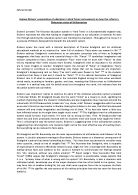Using Chapters 1-3 of 'Hard Times', discuss Dickens presentation and criticism of the Education for the Labouring class
Using Chapters 1-3 of ‘Hard Times’, discuss Dickens presentation and criticism of the Education for the Labouring class.
Dickens presents his criticism of the education for the labouring class in a sarcastic manner. He has created the classroom as a factory. The purpose of the education in Coketown is to root out the innocence and imagination of young children so they will grow into utilitarian robots expecting nothing more than the drudgery of industrial life. Dickens uses specific methods to put his point across of ‘bad education’ by using negative views. This is done with exaggeration because he wants the reader to think the same as what he thinks so it seems like education was extreme and intense. In ‘Hard Times’, the teachers fulfil the excessive teaching skills as they just want the ‘little vessels’ to be filled with facts. Dickens also presents a contrast between two children to show how differently each child gets treated because of their background or their attitude towards things other than facts. Another method that he uses is making the characters stand out through their names to symbolise their personality.
Throughout chapters 1-3, Dickens emphasises on the word 'facts’ because he wants to continuously present and criticise the education for the labouring class. ‘Now, what I want is, Facts. Teach these boys and girls nothing but Facts. Facts alone are wanted in life…’ This is the opening sentence of the novel and straight away you have a vague idea of the extremism of teaching. Also the word ‘fact’ is in capital letters and this signifies the importance of learning nothing but facts. The introduction of the teacher has a lot of exaggeration at hand. Thomas Gradgrind is a middle-class, self-made man. ‘A man of realities…a man of facts and calculations’. Dickens has made this character a very hard and cold teacher who knows what he wants from the students. ‘He seemed a kind of cannon loaded to the muzzle with facts…’ Dickens uses military imagery to show how the teacher wants to get rid of childhood imagination. ‘He seemed a galvanising apparatus, too, charged with a grim mechanical substitute for the tender young imaginations that were to be stormed away’. Dickens has described this as some sort of physics experiment because ‘galvanising’ is the process named after Galvan in the stimulation of animal tissue by electric currents. But in this case it is the young children that are being stimulated with factual currents. Dickens has made the teacher to be very hard-hearted and cruel and this is to present his criticism on the education for the labouring class because he evidently disagrees with this concept of teaching and he wants the readers to feel the same way by using the different language techniques and this is mostly done through exaggeration.







